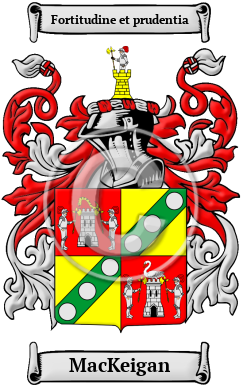| ![Show Contents]() MacKeigan History, Family Crest & Coats of Arms MacKeigan History, Family Crest & Coats of Arms
- Origins Available:
Ireland
Etymology of MacKeiganWhat does the name MacKeigan mean? Hundreds of years ago, the Gaelic name used by the MacKeigan family in Ireland was Mac Aodhagain, which means "son of Aodh, son of fire," a personal name usually Anglicized as Hugh. A Brehon family originally of Uí Maine, which settled in Ormond. 1 The family claim descent from Saint and Bishop Eoghan (d. 618), "of Ardsratha, now Ardstraw, in the county of Tyrone and diocese of Derry. Descended from Ugaine Mor on the father's side he was thus connected by kindred with the chieftains of Leinster, while through his mother, Muindech, he claimed relationship with the Ulster families." 2 Another source confirms the name descends from "the cineal Eoghain, [who] were the ' genus' or progeny of Eoghan, a great Irish chief contemporary with St. Patrick. The name is Anglicized to Owen and Eugene. " 3 Early Origins of the MacKeigan familyThe surname MacKeigan was first found in County Tipperary (Irish: Thiobraid Árann), established in the 13th century in South-central Ireland, in the province of Munster, where they held a family seat from very ancient times. The ancient Egans were lawyers of Ui Maine, a region which is today called Galway, Roscommon and Offaly. The earliest surviving Irish law manuscript, In Senchas Már, was written prior to 1350 at a school (patronized by Mac Aodhagain) at Duniry, near Loughrea. Early History of the MacKeigan familyThis web page shows only a small excerpt of our MacKeigan research. Another 137 words (10 lines of text) covering the years 1172 and 1740 are included under the topic Early MacKeigan History in all our PDF Extended History products and printed products wherever possible. MacKeigan Spelling VariationsPronunciation, rather than spelling, guided scribes and church officials when recording names during the Middle Ages. This practice often resulted in one person's name being recorded under several different spellings. Numerous spelling variations of the surname MacKeigan are preserved in these old documents. The various spellings of the name that were found include Egan, Eagan, Keegan, MacEgan, Kegan, Keagan and many more. Early Notables of the MacKeigan familyAnother 38 words (3 lines of text) are included under the topic Early MacKeigan Notables in all our PDF Extended History products and printed products wherever possible. Migration of the MacKeigan familyA massive amount of Ireland's native population left the island in the 19th century for North America and Australia in hopes of finding more opportunities and an escape from discrimination and oppression. A great portion of these migrants arrived on the eastern shores of the North American continent. Although they were generally poor and destitute, and, therefore, again discriminated against, these Irish people were heartily welcomed for the hard labor involved in the construction of railroads, canals, roadways, and buildings. Many others were put to work in the newly established factories or agricultural projects that were so essential to the development of what would become two of the wealthiest nations in the world. The Great Potato Famine during the late 1840s initiated the largest wave of Iris immigration. Early North American immigration and passenger lists have revealed a number of people bearing the name MacKeigan or a variant listed above: Rev. Michael Egan who became Bishop of Philadelphia in 1790. Many other Egans settled in this city during the 19th century.
| Contemporary Notables of the name MacKeigan (post 1700) | + |
- Wendy MacKeigan, Canadian producer and writer, known for The Water Brothers (2012-2017) and Amazon Adventure (2017)
- Len MacKeigan, Canadian producer and writer, known for The Ha!ifax Comedy Fest (2014) and Trailer Park Boys (2001)
The motto was originally a war cry or slogan. Mottoes first began to be shown with arms in the 14th and 15th centuries, but were not in general use until the 17th century. Thus the oldest coats of arms generally do not include a motto. Mottoes seldom form part of the grant of arms: Under most heraldic authorities, a motto is an optional component of the coat of arms, and can be added to or changed at will; many families have chosen not to display a motto.
Motto: Fortitudine et prudentia
Motto Translation: With fortitude and prudence.
- MacLysaght, Edward, Irish Families Their Names, Arms and Origins 4th Edition. Dublin: Irish Academic, 1982. Print. (ISBN 0-7165-2364-7)
- Smith, George (ed), Dictionary of National Biography. London: Smith, Elder & Co., 1885-1900. Print
- Lower, Mark Anthony, Patronymica Britannica, A Dictionary of Family Names of the United Kingdom. London: John Russel Smith, 1860. Print.
 |

